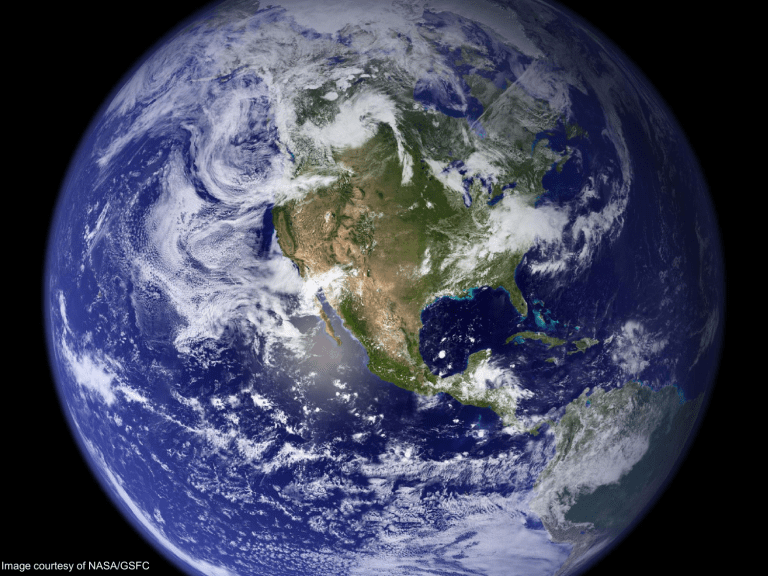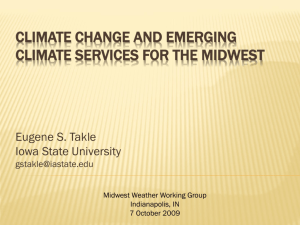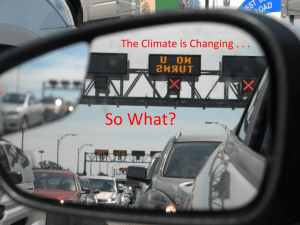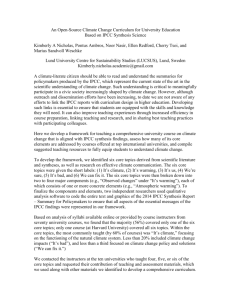Image courtesy of NASA/GSFC

Image courtesy of NASA/GSFC
Current Efforts in Climate
Forecasting and Modeling
Eugene S. Takle
Director, Climate Science Initiative
Professor of Atmospheric Science
Department of Geological and Atmospheric Sciences
Professor of Agricultural Meteorology
Department of Agronomy
Iowa State University
Ames, Iowa 50011 gstakle@iastate.edu
Greenhouse Gases, Carbon Taxes and Trading, and Carbon Sequestration
CHE 670 – Sustainability Seminar
Kansas State University
Manhattan, KS
6-8 Jan 2010
Outline
Changes in atmospheric carbon dioxide
Causes of climate change
Changes in future climate around the globe
Emission reductions to reach stabilization
Climate change for the US
Midwest
MTons Carbon
IPCC Third Assessment Report
Global Carbon Emissions (Gt)
Actual emissions are exceeding worst case scenarios projected in 1990
Carbon Dioxide and Temperature
Carbon Dioxide and Temperature
2010
384 ppm
Carbon Dioxide and Temperature
“Business as Usual”
950 ppm
(2100)
Carbon Dioxide and Temperature
“Business as Usual”
950 ppm
(2100)
?
Increasing greenhouse gases increases heating of the
Earth
Increased Greenhouse Gases
=> Global Heating
Global Mean Surface Temperature
http://www.ncdc.noaa.gov/img/climate/research/2008/ann/global-jan-dec-error-bar-pg.gif
Global Mean Surface Temperature
I II III IV http://www.ncdc.noaa.gov/img/climate/research/2008/ann/global-jan-dec-error-bar-pg.gif
Energy intensive
Balanced fuel sources
More environmentally friendly
If current emission trends continue, global temperature rise will exceed worst case scenarios projected in 2007
IPCC Fourth Assessment Report Summary for Policy Makers
FI =fossil intensive
4.0
3.5
December-
January-
February
Temperature
Change
A1B Emission
Scenario
2080-2099 minus1980-1999
2.5
3.0
June-July-
August
Temperature
Change
A1B Emission
Scenario
2080-2099 minus1980-1999
Source: IPCC 4 th Assessment Report, 2007
0.1
0.0
December-
January-
February
Precipitation
Change
A1B Emission
Scenario
2080-2099 minus1980-1999
Source: IPCC 4 th Assessment Report, 2007
0.0
-0.1
June-July-
August
Precipitation
Change
A1B Emission
Scenario
2080-2099 minus1980-1999
Change in Annual Cloud Cover
Change in Annual Cloud Cove r
A1B Emission
Scenario
2080-2099 minus1980-1999
-1.0
-1.5
Annual Change in Soil Moisture
Annual Change in Soil Moisture
-5
0
A1B Emission
Scenario
2080-2099 minus1980-1999
Imminent Transition to Arid Climate
Precipitation minus
Evaporation for
Western US
25N-40N, 95W-
125 W
(land areas only)
R. Seager, et al.,2007. Model Projections of an Imminent Transition to a More Arid
Climate in Southwestern North America. Science , Vol. 316. no. 5828, pp. 1181 - 1184
Precipitation minus
Evaporation for
Western US
(25N-40N, 95W-
125 W)
R. Seager, et al.,
2007. Model Projections of an Imminent
Transition to a More Arid
Climate in Southwestern
North America. Science ,
Vol. 316. no. 5828, pp. 1181 - 1184
Precipitation minus Evaporation for Western US
(25N-40N, 95W-125 W)
R. Seager, et al.,2007. Model Projections of an Imminent Transition to a More Arid
Climate in Southwestern North America. Science , Vol. 316. no. 5828, pp. 1181 - 1184
Precipitation minus Evaporation for Western US
(25N-40N, 95W-125 W)
Colorado River Compact established, 1922
R. Seager, et al.,2007. Model Projections of an Imminent Transition to a More Arid
Climate in Southwestern North America. Science , Vol. 316. no. 5828, pp. 1181 - 1184
Cooling Decade in a Century of Warming
Probability of a cooling decade in a century of warming
Probability distribution functions for decadal trends (kelvin/year) in globally averaged surface air temperature
Easterling, D. R., and M. F. Wehner, 2009: Is the climate warming or cooling? Geophys. Res. Lett ., 36 , L08706, doi:10.1029/2009GL037810, 2009
Rise in global mean temperature ( o C)
Rise in global mean temperature ( o C)
Rise in global mean temperature ( o C)
Energy intensive
Balanced fuel sources
More environmentally friendly
Limit to avoid “dangerous anthropogenic
Interference” with the climate system
2 o C limit
IPCC Fourth Assessment Report Summary for Policy Makers
Energy intensive
Balanced fuel sources
More environmentally friendly
If current emission trends continue, global temperature rise likely will exceed worst case scenarios projected in 2007
2 o C “Guardrail”
2 o C limit to avoid “dangerous anthropogenic interference” with the climate system
IPCC Fourth Assessment Report Summary for Policy Makers
FI =fossil intensive
Long-Term Stabilization Profiles
Future trend of current emissions
A2
Emission scenario needed to provide 50% probability of not exceeding the 2 o C guardrail
B1
Nebojša Nakićenović IIASA, Vienna
Options for Climate Stabilization
Options for Climate Stabilization
Source: IPCC, 2001: Climate Change 2001: The Scientific Basis
Source: IPCC, 2001: Climate Change 2001: The Scientific Basis
Arctic Sea-Ice Decline
Decline in Greenland Ice Mass
Increase in Hurricane Intensity
Energy intensive
Balanced fuel sources
More environmentally friendly
The planet is committed to a warming over the next 50 years regardless of political decisions
IPCC Fourth Assessment Report Summary for Policy Makers
Energy intensive
Balanced fuel sources
More environmentally friendly
Mitigation
Possible
Adaptation
Crucial
Adaptation
Necessary
IPCC Fourth Assessment Report Summary for Policy Makers
Observed Summer (JJA) Daily Maximum Temperature
Changes (K), 1976-2000
Adapted from
Folland et al.
[2001]
“Warming
Hole”:
Simulations of changes in daily maximum summertime temperatures between 1990s and 2040s
D T max
(JJA) ˚C
Pan, Z., R. W. Arritt, E. S. Takle, W. J. Gutowski, Jr., C. J. Anderson, and M. Segal,2004: Altered hydrologic feedback in a warming climate introduces a “warming hole”. Geophys. Res. Lett.31, L17109, doi:10.1029/2004GL020528.
“One of the clearest trends in the United
States observational record is an increasing frequency and intensity of heavy precipitation events…
Over the last century there was a 50% increase in the frequency of days with precipitation over
101.6 mm (four inches) in the upper midwestern U.S.; this trend is statistically significant “
Projected Changes* for the
Climate of the Midwest
Temperature
Longer frost-free period (high)
Higher average winter temperatures (high)
Fewer extreme cold temperatures in winter (high)
Fewer extreme high temperatures in summer in short term but more in long term (medium)
Higher nighttime temperatures both summer and winter (high)
More freeze-thaw cycles (high)
Increased temperature variability (high)
Follows trend of last 25 years and projected by models
No current trend but model suggestion or current trend but model inconclusive
*Estimated from IPCC reports
Projected Changes* for the
Climate of the Midwest
Precipitation
More (~10%) precipitation annually (medium)
Change in “seasonality”: Most of the increase will come in the first half of the year (wetter springs, drier summers) (high)
More water-logging of soils (medium)
More variability of summer precipitation (high)
More intense rain events and hence more runoff (high)
Higher episodic streamflow (medium)
Longer periods without rain (medium)
Higher absolute humidity (high)
Stronger storm systems (medium)
More winter soil moisture recharge (medium)
Snowfall increases (late winter) in short term but decreases in the long run (medium)
Follows trend of last 25 years and projected by models
No current trend but model suggestion or current trend but model inconclusive
*Estimated from IPCC reports
Projected Changes* for the
Climate of the Midwest
Other
Reduced wind speeds (high)
Reduced solar radiation (medium)
Increased tropospheric ozone (high)
Accelerated loss of soil carbon (high)
Phenological stages are shortened (high)
Weeds grow more rapidly under elevated atmospheric
CO2 (high)
Weeds migrate northward and are less sensitive to herbicides (high)
Plants have increased water used efficiency (high)
Follows trend of last 25 years and projected by models
No current trend but model suggestion or current trend but model inconclusive
* Estimated from IPCC and CCSP reports
Summary
Increases in CO2 will create a wide variety of climate changes
Some regions will experience changes favorable for local societal activities, but most will be unfavorable
Stabilization to avoid passing the
2oC guardrail will require major decreases in global emissions
Many, but not all, observed regional climate changes are consistent with global and regional climate model projections




